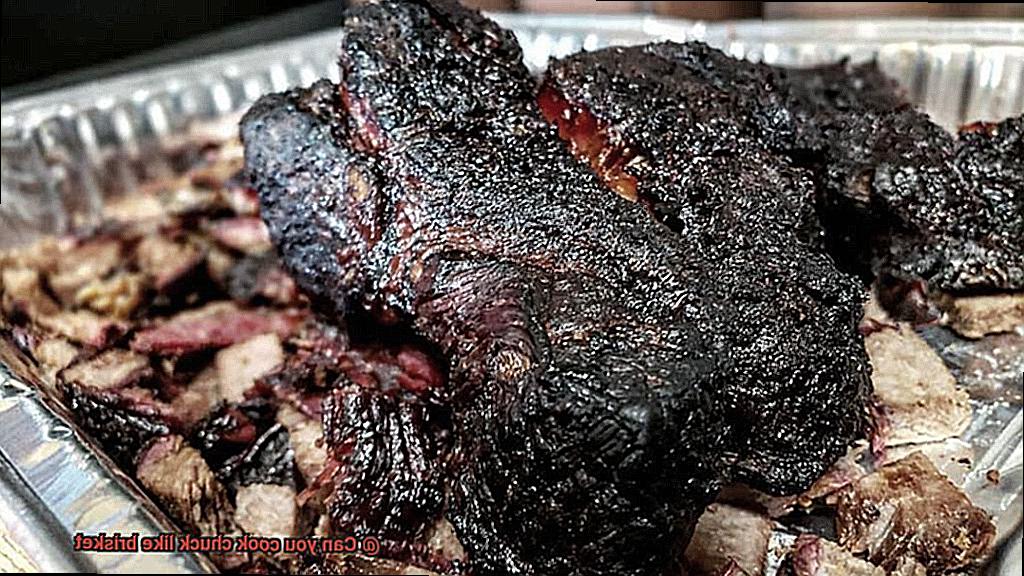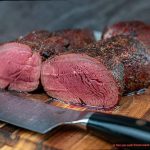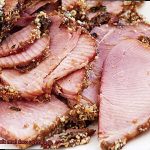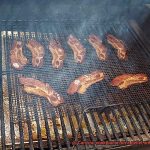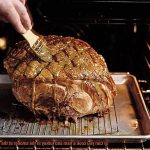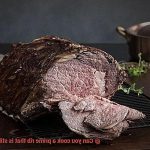Do you salivate at the thought of a perfectly cooked brisket? That smoky flavor and melt-in-your-mouth texture is hard to resist. But let’s be real, brisket can come with a hefty price tag. Fear not, my fellow meat lovers. You can achieve that same deliciousness by cooking chuck like brisket.
Chuck is often overlooked as a beef cut, but it’s more affordable than brisket and has plenty of marbling for slow-cooking. Don’t believe me? Just wait until you sink your teeth into this savory dish.
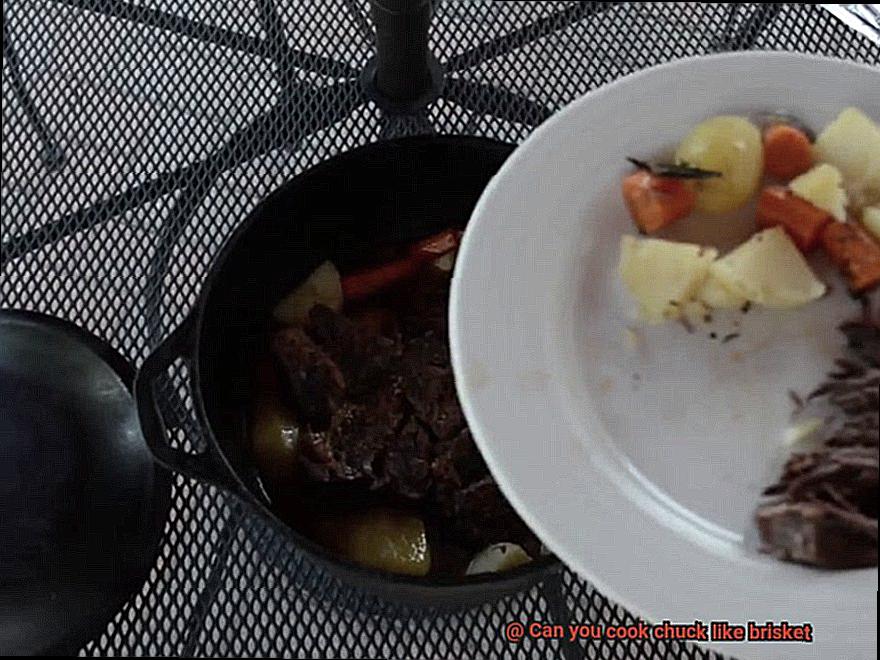
In this blog post, we’ll explore the similarities between chuck and brisket and provide you with the best methods for cooking chuck to perfection. From seasoning to cooking times and temperature, we’ve got you covered. Whether you’re a beginner or an experienced cook, these tips will help you create a mouthwatering chuck roast every time.
So why settle for less when you can have tender and juicy beef that rivals even the most expensive cuts? Follow along as we show you how to cook chuck like brisket. Let’s get started on this meaty adventure.
Contents
What is Chuck and Brisket?
Chuck and brisket come from the front part of the cow, also known as the shoulder, and are known for their rich flavor and substantial marbling.
Chuck is a flavorful cut that comes from the shoulder blade area of the cow. It has a lot of connective tissue, which means that it can be tough if cooked quickly at high heat. However, when it is cooked slowly at low heat, the connective tissue breaks down and turns into gelatin, making the meat tender and juicy. Chuck is commonly used for pot roasts, stews, and ground beef.
Brisket, on the other hand, comes from the lower chest area of the cow. It’s a tough cut that’s full of collagen, which makes it perfect for slow cooking. When cooked low and slow, the collagen breaks down and turns into gelatin, resulting in tender and juicy meat. Brisket is a popular cut for smoking and barbecuing and is often used to make classic dishes like Texas-style barbecue.
One of the key differences between chuck and brisket is their taste. Chuck has a beefier taste compared to brisket, which has a more complex flavor profile due to its fat content. Brisket is also known for its signature bark (crust) that forms when it’s smoked or grilled.
When it comes to cooking these cuts of beef, both require low and slow methods to break down their respective tough tissues. Brisket is typically cooked using the Texas-style BBQ method, which involves smoking the meat for several hours at a low temperature. This process allows the meat to become tender and flavorful, with a signature bark that forms on the outside.
But what if you want to cook chuck like brisket? It’s possible. Start by seasoning the meat with your desired spices and marinating it overnight in the fridge. Then, preheat your smoker or grill to a low temperature (around 225-250 degrees Fahrenheit) and place the chuck roast on it. Let it cook for several hours until it reaches an internal temperature of around 195-205 degrees Fahrenheit. This can take anywhere from 6-10 hours depending on the size of your roast.
Differences Between Chuck and Brisket
Let’s start with where they come from. Chuck is sourced from the shoulder area of the cow, while brisket is taken from the chest. This translates to chuck being tougher due to its higher connective tissue content, but also having more flavor. On the other hand, brisket is known for its tenderness and distinct taste, but requires longer cooking time to break down its tough tissues.
Both cuts require low and slow cooking, but how they’re prepared differs. Chuck is ideal for slow-cooking dishes like stews and pot roasts, while brisket is often used in barbecue dishes like smoked brisket.
When it comes to fat content, chuck is generally fattier than brisket, which can make it more challenging to cook but also more flavorful. Brisket has a unique “fat cap” layer that helps keep the meat moist during cooking.
So, which cut should you choose? It depends on what you’re making and your personal preferences. If you want melt-in-your-mouth tenderness for your barbecue, go for brisket. If you’re after a beefy flavor for your stew or pot roast, choose chuck.
How to Cook Chuck Like Brisket
Although chuck and brisket are different cuts of beef, with the right techniques, you can achieve a similar taste and texture. Here are some tips to cook chuck like brisket:
Understanding the Differences:
Before diving into cooking chuck like brisket, it’s essential to understand the differences between the two cuts of meat. Brisket is a tougher cut that requires low and slow cooking methods to break down the connective tissues, while chuck is a more tender cut that can be cooked at higher temperatures.
Low and Slow Cooking Methods:
One popular method for cooking chuck like brisket is smoking it. Start by seasoning the meat with your desired spices and marinating it overnight in the fridge. Then, preheat your smoker or grill to a low temperature (around 225-250 degrees Fahrenheit). Place the chuck roast on the smoker or grill and let it cook for several hours until it reaches an internal temperature of around 195-205 degrees Fahrenheit. This can take anywhere from 6-10 hours depending on the size of your roast.
Braising:
Another option is braising the chuck roast. Begin by searing it on all sides in a hot pan before transferring it to a Dutch oven or other heavy pot with some liquid (such as beef broth, red wine, or tomato sauce). The meat is then cooked in the liquid at a low temperature for several hours until it becomes fork-tender. This method can be done on the stovetop or in the oven and typically takes several hours.
Resting:
After cooking, let the meat rest for at least 30 minutes before slicing it against the grain. This will help ensure that each bite is tender and packed with flavor. Using a meat thermometer is crucial to ensuring that the internal temperature reaches at least 145°F for safe consumption.
Differences in Taste:
While chuck may not have the same level of smokiness and tenderness as brisket, it is still possible to achieve a delicious and satisfying meal using this cut of meat. Chuck tends to be a bit fattier than brisket, which can affect the overall flavor of the dish. However, with the right seasoning and cooking methods, you can still achieve a mouth-watering BBQ beef dish using chuck.
Prepping the Chuck Roast
Well then, let’s dive into the essential steps of prepping your chuck roast to ensure that it’s bursting with flavor and tenderness.
First and foremost, trimming the excess fat is crucial. Unlike brisket, which has a thick layer of fat, chuck roast has a thinner layer that can become tough if left on during cooking. Use a sharp knife to trim any large pieces of fat while leaving behind a thin layer to add flavor and moisture.
Seasoning is the key to enhancing the natural flavors of the beef. A simple salt and pepper rub is great, but don’t be afraid to get creative with other seasonings like garlic powder, onion powder, or paprika. Rub your chosen seasonings onto the entire surface of the meat and let it sit for at least 30 minutes before cooking.
If you’re looking to add more depth and flavor to your meat, marinating is an excellent option. You can use a store-bought marinade or create your own with ingredients like soy sauce, Worcestershire sauce, olive oil, and herbs. Place your chuck roast in a ziplock bag or shallow dish with the marinade and let it sit in the refrigerator for at least 2 hours or overnight for maximum flavor absorption.
Now it’s time to cook your chuck roast using a low and slow method like smoking or braising. This will result in juicy and tender meat that will melt in your mouth. Cook the roast at a temperature between 225-250°F for several hours until it reaches an internal temperature of 200°F. And don’t forget to rest your meat for at least 30 minutes before slicing to allow the juices to redistribute throughout the roast.
Low and Slow Cooking Method
Look no further than the low and slow cooking method for chuck and brisket. As an expert in this topic, I can attest that this technique is a game-changer when it comes to transforming tough cuts of meat into succulent and mouth-watering dishes.
What makes this cooking method so effective? Low and slow cooking involves cooking meat at a low temperature for an extended period of time, which allows for the connective tissues in the meat to break down and create a tender and juicy final product. These tougher cuts of meat like chuck and brisket are notoriously difficult to cook but with the low and slow method, they can be elevated to new levels of flavor.
So let’s dive into the process. The first step is to season your chuck or brisket with a dry rub or marinade, allowing your creativity to shine through with your favorite spices and flavors. Then, the meat should be cooked on a smoker or grill using indirect heat at a low temperature between 225-250 degrees Fahrenheit. This is where the “slow” part comes in – the meat should cook for several hours until it reaches an internal temperature of 195-205 degrees Fahrenheit.
It’s crucial to monitor the temperature of the meat throughout the cooking process using a meat thermometer. This will ensure that it’s cooked to perfection, without overcooking or drying out. Once it reaches the desired temperature, remove it from the heat and let it rest for at least 30 minutes before slicing and serving.
One of the great things about this cooking method is its versatility – both chuck and brisket can be transformed into tender and juicy dishes with low and slow cooking. While brisket may be more expensive than chuck, both cuts can be equally delicious if cooked correctly.
Temperature for Cooking Chuck Roast
Look no further, as I am here to share with you the secrets of low and slow cooking. The first step in cooking a perfect chuck roast is to set your oven or grill to 225-250°F, allowing the meat to cook through slowly and become tender.
But how long should you cook it for? This depends on the size of your roast, but generally, it can take anywhere from 6-8 hours. Don’t worry, though – you don’t have to spend all day watching over it. Just set a timer and let the magic happen while you go about your day.
Now, here comes the crucial part – monitoring the internal temperature of your meat. To ensure that your chuck roast is fully cooked and tender, use a meat thermometer to check that it has reached an internal temperature of around 200-205°F. This may require some trial and error as every oven or grill is different, but trust me, it’s worth taking the time to get it right.
It’s also important to note that if you are using a grill, you may need to adjust the temperature or rotate the meat periodically for even cooking.
Resting the Meat Before Slicing
You’ve done it. The perfect chuck roast or brisket is sizzling hot and ready to go. But before you break out your carving knife, take a moment to consider the importance of letting your meat rest.
Resting is a simple yet vital step that involves taking the cooked meat off the heat and letting it sit for a period of time before slicing. During this time, the meat redistributes its juices evenly throughout the cut, yielding a more succulent and flavorful result.
Here are some reasons why you should make resting an essential part of your cooking routine:
- Retention of moisture: When meat is cooked, its juices move toward the center of the cut. Resting allows these juices to redistribute back throughout the meat, rather than spilling out onto your cutting board.
- Uniform cooking: By letting your meat rest, you ensure that it continues cooking evenly even after it’s been removed from heat. This is especially important for thicker cuts of meat.
- Enhanced texture: Resting also helps to relax the muscle fibers in the meat, yielding a more tender and easier-to-chew final product.
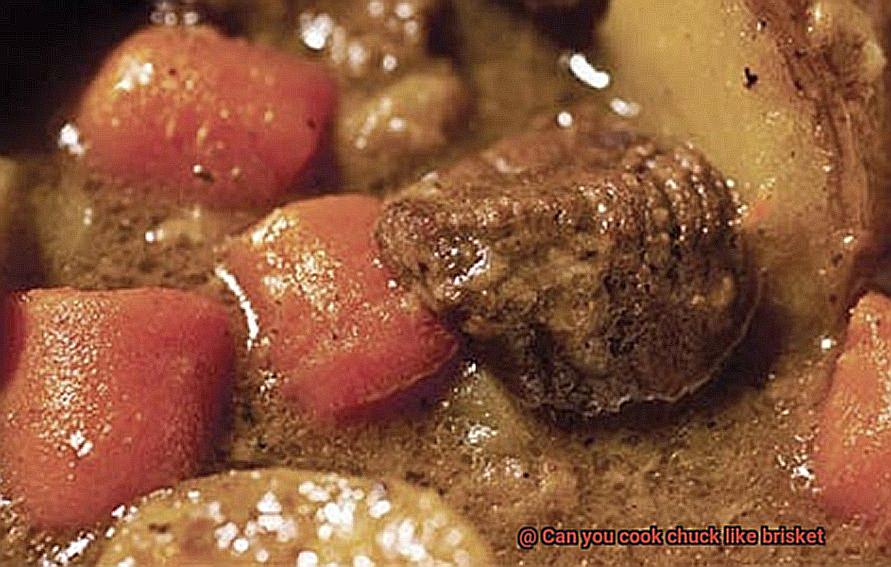
Now that you understand why resting is so crucial, here are some tips on how to do it right:
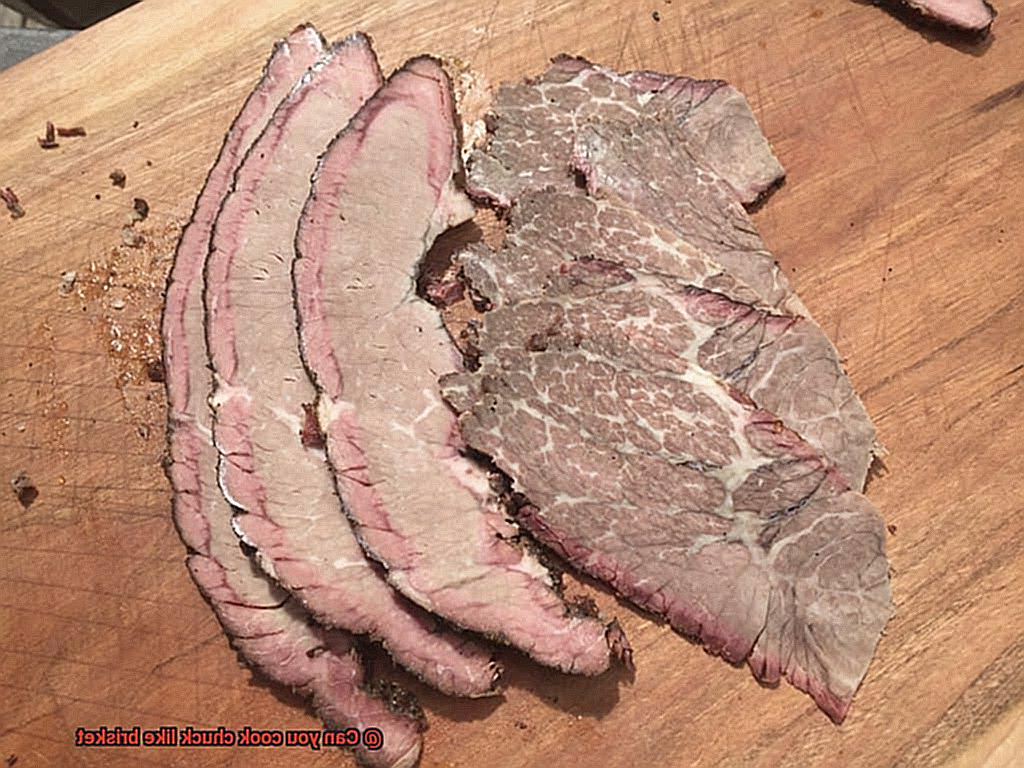
- Timing: Aim to rest your meat for at least 10-15 minutes, but keep in mind that larger cuts may require up to 30 minutes. Thicker cuts will retain heat longer and thus require a longer resting time.
- Covering: While resting, cover your meat loosely with aluminum foil to keep it warm and prevent it from drying out.
- Slicing: When it’s time to slice your meat, be sure to cut against the grain for maximum tenderness and flavor. You can identify the grain by looking for lines or striations on the surface of the meat.
Possible Differences in Taste and Texture Compared to Traditional Brisket
Well, chuck might just be the alternative you’ve been searching for. But before you dive in, it’s important to understand the possible differences in taste and texture compared to traditional brisket.
Let’s start with the basics – where do these cuts of meat come from? Brisket is taken from the cow’s breast, while chuck comes from the shoulder. As a result, they have different amounts of fat and connective tissue, which can greatly impact their cooking and taste.
Brisket is famous for its rich, beefy flavor and tender texture when cooked low and slow. The high amount of connective tissue in brisket breaks down during cooking, resulting in a melt-in-your-mouth texture that’s hard to resist. Chuck, on the other hand, has more marbling and fat content than brisket. This can lead to a juicier finished product but can also result in a tougher texture if not cooked properly.
So, what does this mean for cooking chuck like brisket? It’s crucial to keep these differences in mind. While chuck can be a great substitute for brisket in terms of flavor and tenderness, it may not offer the same level of richness or melt-in-your-mouth texture.
But don’t let that discourage you. With proper preparation and cooking techniques, you can still achieve a tender and flavorful finished product that rivals traditional brisket. Here are some tips:
- Keep an eye on the temperature: As with any cut of meat, temperature is key when cooking chuck like brisket. Aim for a temperature between 195-205°F for optimal tenderness.
- Season generously: Chuck may not have the same depth of flavor as brisket, so don’t be shy with your seasonings. Use a rub or marinade to enhance the meat’s natural flavors.
- Consider smoking: Smoking is a great way to infuse flavor into chuck and can help achieve a more tender texture.
- Rest before carving: Just like with brisket, it’s important to let your chuck rest for at least 30 minutes before carving. This allows the juices to redistribute and results in a more flavorful finished product.
8c90uiKloYc” >
Conclusion
To sum up, chuck can be cooked like brisket with great success. This is a fantastic option for those who want to experience the heavenly texture and smoky taste of brisket without spending a fortune. Chuck is often overlooked as a cut of beef, but it has ample marbling that makes it perfect for slow-cooking. By using the right techniques, you can turn this humble cut into a mouthwatering dish that will leave your taste buds singing.
Although there are differences between chuck and brisket in terms of flavor, fat content, and cooking methods, both cuts require low and slow cooking to break down their tough tissues. Smoking or braising are popular ways to cook chuck like brisket. However, it’s essential to keep an eye on the internal temperature of the meat with a meat thermometer to ensure that it’s cooked perfectly.
Resting the meat before slicing is also crucial for achieving maximum tenderness and flavor. While there may be some variations in taste and texture compared to traditional brisket, with proper preparation and cooking techniques, you can still achieve a delicious and satisfying meal using chuck.
So why settle for less when you can have tender and juicy beef that rivals even the most expensive cuts? Follow these tips to cook chuck like brisket and embark on this meaty adventure.

